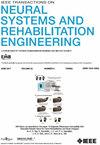多发性硬化症患者和健康对照者行走和避障时的脑连通性:一项初步脑电图研究
IF 5.2
2区 医学
Q2 ENGINEERING, BIOMEDICAL
IEEE Transactions on Neural Systems and Rehabilitation Engineering
Pub Date : 2025-07-24
DOI:10.1109/TNSRE.2025.3592492
引用次数: 0
摘要
本研究调查了多发性硬化症(pwMS)患者与健康对照组(HC)在两种行走条件下的有效连通性和半球不对称性:单独行走和避免不可预测的障碍物行走。认知-运动干扰(CMI)采用脑电图(EEG)跨β、α和θ频段进行分析。定向功能连通性估计使用部分定向相干性(PDC)来评估条件和组之间连接模式的差异。在健康对照中,避障增加了运动和认知区域的连通性,包括左中央(LC)、左颞(LT)和右额叶(RF)区域本文章由计算机程序翻译,如有差异,请以英文原文为准。
Brain Connectivity During Walking and Obstacle Avoidance in Persons With Multiple Sclerosis and Healthy Controls: A Pilot EEG Study
This study investigated effective connectivity and hemispheric asymmetry in persons with multiple sclerosis (pwMS) compared to healthy controls (HC) during two walking conditions: walking alone and walking while avoiding unpredictable obstacles. Cognitive-motor interference (CMI) was analyzed using electroencephalography (EEG) across beta, alpha, and theta frequency bands. Directed functional connectivity was estimated using partial directed coherence (PDC) to assess differences in connectivity patterns between conditions and groups. In healthy controls, obstacle avoidance increased connectivity in motor and cognitive regions including left central (LC), left temporal (LT), and right frontal (RF) regions, p<0.0014.> $= -0.65$ ), indicating compensatory but inefficient neural engagement. These findings highlight disruptions in brain connectivity during motor-cognitive tasks in pwMS, with potential implications for designing targeted rehabilitation strategies to improve gait and neural efficiency.
求助全文
通过发布文献求助,成功后即可免费获取论文全文。
去求助
来源期刊
CiteScore
8.60
自引率
8.20%
发文量
479
审稿时长
6-12 weeks
期刊介绍:
Rehabilitative and neural aspects of biomedical engineering, including functional electrical stimulation, acoustic dynamics, human performance measurement and analysis, nerve stimulation, electromyography, motor control and stimulation; and hardware and software applications for rehabilitation engineering and assistive devices.

 求助内容:
求助内容: 应助结果提醒方式:
应助结果提醒方式:


